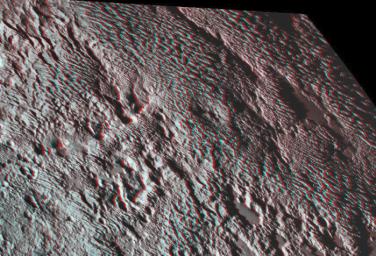
|
Pluto’s Bladed Terrain in 3-D
- Click the image above for a larger view
- Full-Res JPEG (855 x 582) (179.9 kB)
- Full-Res TIFF (855 x 582) (1.5 MB)
Caption:
One of the strangest landforms spotted by NASA's New Horizons spacecraft when it flew past Pluto last July was the "bladed" terrain just east of Tombaugh Regio, the informal name given to Pluto's large heart-shaped surface feature.
The blades are the dominant feature of a broad area informally named Tartarus Dorsa. They align from north to south, reach hundreds of feet high and are typically spaced a few miles apart. This remarkable landform, unlike any other seen in our solar system, is perched on a much broader set of rounded ridges that are separated by flat valley floors.
This amazing stereo view combines two images from the Ralph/Multispectral Visible Imaging Camera (MVIC) taken about 14 minutes apart on July 14, 2015. The first was taken when New Horizons was 16,000 miles (25,000 kilometers) away from Pluto, the second when the spacecraft was 10,000 miles (about 17,000 kilometers) away. Best resolution is approximately 1,000 feet (310 meters).
Background Info:
The Johns Hopkins University Applied Physics Laboratory in Laurel, Maryland, designed, built, and operates the New Horizons spacecraft, and manages the mission for NASA's Science Mission Directorate. The Southwest Research Institute, based in San Antonio, leads the science team, payload operations and encounter science planning. New Horizons is part of the New Frontiers Program managed by NASA's Marshall Space Flight Center in Huntsville, Alabama.
Cataloging Keywords:
| Name | Value | Additional Values |
|---|---|---|
| Target | Pluto | |
| System | Pluto | Kuiper Belt |
| Target Type | Dwarf Planet | KBO |
| Mission | New Horizons | |
| Instrument Host | New Horizons | |
| Host Type | Flyby Spacecraft | |
| Instrument | Long Range Reconnaissance Imager (LORRI) | Multispectral Visible Imaging Camera (MVIC) |
| Detector | ||
| Extra Keywords | Color | |
| Acquisition Date | ||
| Release Date | 2016-03-31 | |
| Date in Caption | 2015-07-14 | |
| Image Credit | NASA/Johns Hopkins University Applied Physics Laboratory/Southwest Research Institute | |
| Source | photojournal.jpl.nasa.gov/catalog/PIA20544 | |
| Identifier | PIA20544 | |
